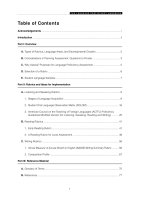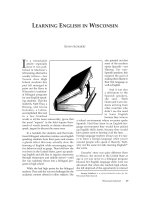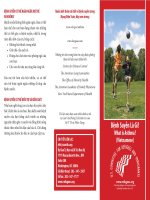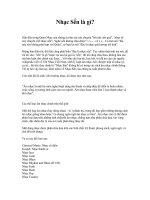Tài liệu Gr 7-8 LA Standards doc
Bạn đang xem bản rút gọn của tài liệu. Xem và tải ngay bản đầy đủ của tài liệu tại đây (93.77 KB, 30 trang )
Grade
7-8
Language Arts
Minnesota
Academic
Standards
DRAFT
August 26, 2003
CONTENTS
LANGUAGE ARTS
ORGANIZATION OF THIS DOCUMENT 2-3
FRAMEWORK FOR THE K-12 LANGUAGE ARTS STANDARDS 4-5
LANGUAGE ARTS STANDARDS 6-27
I. READING AND LITERATURE 6-9
II. WRITING 10-13
III. SPEAKING, LISTENING AND VIEWING 14-15
I. READING AND LITERATURE 16-21
II. WRITING 22-25
III. SPEAKING, LISTENING AND VIEWING 26-27
G
R
A
D
E
7-8
G
R
A
D
E
8
G
R
A
D
E
7
1
The Minnesota Academic Standards in Language Arts are
organized by grade level into three general strands: 1) Reading and
Literature, 2) Writing, and 3) Speaking, Listening and Viewing.
One or more categories or sub-strands of standards are listed under
each strand. For example, the Reading and Literature strand
includes the sub-strands of Word Recognition, Analysis and
Fluency, Vocabulary Expansion, Comprehension and Literature.
Each standard begins with the phrase, “The student will…” and is
followed by several benchmarks that describe the specific
knowledge or skills that students should acquire by the end of that
grade level.
The strands are identified by Roman numerals (I, II, III) and the
sub-strands by upper case letters (A, B, C, etc.). The standards are
noted by the word “Standard” and are followed by a list of
benchmarks identified by ordinal numbers (1, 2, 3, etc.). The
example illustrates the relationship between a strand, sub-strand,
standard and benchmarks.
ORGANIZATION OF THIS DOCUMENT
G
R
A
D
E
7-8
2
Example
KINDERGARTEN
Strand I. READING AND LITERATURE
The student will listen to and understand grade-
appropriate English language text.
Sub-strand A. Word Recognition, Analysis, and
Fluency
Standard Standard: The student will apply
knowledge of the sounds of the English
language (phonemic awareness) and sound-
symbol relationships (phonics).
Benchmarks The student will:
1. See, hear, say and write the basic sounds
(phonemes) of the English language.
2. Match consonant and short vowel
sounds to appropriate letters, say the
common sounds of most letters, and
begin to write consonant-vowel-
consonant words.
3. Identify and name uppercase and
lowercase letters of the alphabet.
4. Identify beginning consonant sounds and
ending sounds in single-syllable words.
5. Identify, produce and say rhyming words
in response to an oral prompt.
6. Read 10 high-frequency words.
G
R
A
D
E
7-8
The next page outlines the organization of the Language Arts
standards for all grade levels.
3
GRADE LEVEL (Kindergarten, Grade 1, Grade 2, etc.)
I. READING AND LITERATURE
A. Word Recognition, Analysis, and Fluency
Standard statement
1. Benchmark
2. Benchmark, etc.
B. Vocabulary Expansion
Standard statement
1. Benchmark
2. Benchmark, etc.
C. Comprehension
Standard statement
1. Benchmark
2. Benchmark, etc.
D. Literature
Standard statement
1. Benchmark
2. Benchmark, etc.
II. WRITING
A. Types of Writing
Standard statement
1. Benchmark
2. Benchmark, etc.
B. Elements of Composition
Standard statement
1. Benchmark
2. Benchmark, etc.
C. Spelling, Grammar and Usage
Standard statement
1. Benchmark
2. Benchmark, etc.
FRAMEWORK FOR THE K-12
LANGUAGE ARTS STANDARDS
G
R
A
D
E
7-8
4
II. WRITING (continued)
D. Research
Standard statement
1. Benchmark
2. Benchmark, etc.
E. Handwriting and Word Processing
Standard statement
1. Benchmark
2. Benchmark, etc.
III. SPEAKING, LISTENING AND VIEWING
A. Speaking and Listening
Standard statement
1. Benchmark
2. Benchmark, etc.
B. Viewing (grades K-2)
Standard statement
1. Benchmark
2. Benchmark, etc.
C. Media Literacy (grades 3-12)
Standard statement
1. Benchmark
2. Benchmark, etc.
G
R
A
D
E
7-8
5
I. READING AND LITERATURE
The student will read and understand grade-appropriate English
language text.
A. Word Recognition, Analysis and Fluency
Standard: The student will read with accuracy and fluency.
The student will:
1. Read unfamiliar complex and multi-syllabic words
using cueing systems, advanced phonetic analysis and
structural analysis.
2. Read narrative and expository text with fluency,
accuracy and comprehension at an appropriate silent
reading rate.
3. Apply correct word pronunciation and inflection.
LANGUAGE ARTS
G
R
A
D
E
7
6
LANGUAGE ARTS
I. READING AND LITERATURE (continued)
B. Vocabulary Expansion
Standard: The student will use a variety of strategies to
expand reading, listening and speaking vocabularies.
The student will:
1. Acquire, understand and use new vocabulary through
explicit vocabulary instruction and independent
reading.
2. Analyze word structure and use context clues to
understand new words.
3. Recognize and interpret words with multiple meanings.
4. Recognize the influences of other languages on the
English language.
5. Apply knowledge of Greek and Latin roots, prefixes
and suffixes to understand content-area vocabulary and
assist pronunciation.
6. Identify and explain analogies, similes and metaphors.
7. Determine pronunciation, meanings and alternate word
choices through the use of dictionaries, thesauruses and
electronic tools.
G
R
A
D
E
7
7
LANGUAGE ARTS
I. READING AND LITERATURE (continued)
C. Comprehension
Standard: The student will understand the meaning of texts,
using a variety of strategies, and will demonstrate literal,
interpretive, inferential and evaluative comprehension.
The student will:
1. Comprehend, interpret and evaluate text by asking and
answering questions.
2. Recall and use prior learning and preview text to
prepare for reading.
3. Use knowledge of narrative and expository text
structures and subject specific texts to summarize
content.
4. Make inferences and draw conclusions based on
explicit and implied information from texts.
5. Create outlines, logical notes and summaries across
content areas.
6. Use texts’ structural organizers, such as graphics,
illustrations, references, notes, introductions, boldface
type and subheadings to aid comprehension.
7. Distinguish statements of fact from opinion and give
examples from text.
8. Critically read and evaluate to determine the author’s
purpose, point of view, audience and message.
9. Follow written directions in technical reading.
10. Scan a passage to determine relevant information and
skim the text to locate specific information.
11. Identify devices used in persuasive text
G
R
A
D
E
7
8
LANGUAGE ARTS
I. READING AND LITERATURE (continued)
D. Literature
Standard: The student will actively engage in the reading
process and read, understand, respond to, analyze, interpret,
evaluate and appreciate a wide variety of fiction, poetic and
nonfiction texts.
The student will:
1. Read a variety of high-quality, traditional, classical, and
contemporary literary works specific to America, as well as
significant works from other countries.
2. Identify and analyze various genres and subgenres as forms
with distinct characteristics and purposes.
3. Identify and analyze the relationships among elements of
fiction including setting, character, plot, conflict/resolution,
theme, and tone.
4. Identify and analyze the effect of characters’ traits on the
plot and resolution of the conflict.
5. Analyze how figurative language and literary devices
contribute to the meaning of a text.
6. Identify and discuss the effect of the speaker and recognize
the difference between first and third person point of view.
7. Relate a given literary work to historical events (place, time
and custom).
8. Explain how form and stylistic devices convey the meaning
of a poem.
9. Identify and understand recurring themes across literary
works, citing evidence from the texts.
10. Respond to literature using ideas and details from the text to
support reactions and make literary connections.
11. Read from and respond to a variety of fiction, poetic and
nonfiction texts of increasing complexity for personal
enjoyment.
G
R
A
D
E
7
9
LANGUAGE ARTS
II. WRITING
The student will write clearly and coherently to effectively
communicate for a variety of audiences and purposes.
A. Types of Writing
Standard: The student will create informative, expressive
and persuasive writing.
The student will:
1. Write frequently in a variety of forms, including but not
limited to the following: poetry, stories, essays,
editorials, letters, directions and research reports. By the
end of grade 8, the student will have written in all of the
forms listed.
(Writing should be addressed across content areas and
integrated into the curriculum.)
G
R
A
D
E
7
10
LANGUAGE ARTS
II. WRITING (continued)
B. Elements of Composition
Standard: The student will engage in a writing process,
with attention to organization, focus, quality of ideas and a
purpose.
The student will:
1. Create multiple paragraph compositions that state,
maintain and use details in a logical order to support a
main idea.
2. Create narratives that develop settings, people/
characters, dialogue, and conflicts using descriptive,
concrete language to engage audiences.
3. Create informative reports, including gathering
material, formulating ideas based on gathered material,
organizing information, and editing for logical
progression.
4. Employ composing processes to develop writing,
including:
a. prewriting - planning strategies such as
brainstorming, journaling, sketching, listing,
outlining and determining audience, purpose and
focus
b. drafting – organizing, supporting and putting ideas
into sentences and paragraphs
c. revising – improving the quality of content,
organization, sentence structure and word choice
d. editing – correcting errors in spelling and grammar
e. publishing – producing a document and sharing the
writing with the audience.
5. Consider the intended audience when composing text.
(Writing should be addressed across content areas and
integrated into the curriculum.)
G
R
A
D
E
7
11
II. WRITING (continued)
C. Spelling, Grammar and Usage
Standard: The student will apply standard English
conventions when writing. (Use of standard English
conventions is necessary to help a writer convey meaning
to the reader. Spelling, grammar, and usage may be taught
as a separate unit as well as integrated into teaching
writing processes.)
The student will:
1. Compose complete sentences when writing.
2. Edit writing for correct spelling and sentence clarity.
3. Apply grammar conventions correctly in writing,
including:
a. consistent verb tense
b. subject and verb agreement with simple and
compound subjects
c. nominative, reflexive, objective, and possessive
pronouns, pronoun/antecedent agreement
d. subject and verb agreement when interrupted by a
phrase.
4. Apply punctuation conventions correctly in writing,
including:
a. apostrophes
b. semi-colon
c. capitalization of proper nouns
d. abbreviations
e. sentence beginnings and first words in quotes
f. commas (in compound sentences, and after
subordinating conjunctions, noun of address, and
non-essential clauses)
g. quotation marks (to identify dialogue).
(Writing should be addressed across content areas and integrated into the curriculum.)
LANGUAGE ARTS
G
R
A
D
E
7
12
LANGUAGE ARTS
II. WRITING (continued)
D. Research
Standard: The student will locate and use information in
reference materials.
The student will:
1. Formulate questions and collect and assess relevant
information to address these questions.
2. Cite sources for quoted and paraphrased information in
a bibliography when writing a research report.
3. Gather and organize information from a variety of
sources, including electronic and print.
4. Define plagiarism, its consequences and avoid its use.
E. Handwriting and Word Processing
Standard: The student will write legibly and demonstrate
effective keyboarding skills.
The student will:
1. Write legibly using cursive.
2. Format word-processed documents to present
information in an organized, readable format,
integrating graphics, illustrations and bulleting as
needed.
(Writing should be addressed across content areas and
integrated into the curriculum.)
G
R
A
D
E
7
13
III. SPEAKING, LISTENING AND VIEWING
The student will speak clearly and effectively for a variety of
purposes and audiences and actively listen to, view and
evaluate oral communication and media.
A. Speaking and Listening
Standard: Students will demonstrate understanding and
communicate effectively through listening and speaking.
The student will:
1. Participate in and follow agreed-upon rules for
conversation and formal discussions in large and small
groups.
2. Know and apply listening rules for formal settings.
3. Apply assessment criteria to self-evaluate oral
presentations.
4. Distinguish between speaker’s opinion and verifiable
facts and analyze the credibility of the presentation.
5. Follow a speaker’s presentation and represent it in
notes.
6. Orally communicate information, opinions, and ideas
effectively to different audiences for a variety of
purposes.
7. Adjust delivery and language in oral presentations for
the intended audiences and purposes.
8. Perform expressive oral readings of prose, poetry or
drama.
LANGUAGE ARTS
G
R
A
D
E
7
14
III. SPEAKING, LISTENING AND VIEWING (continued)
B. Media Literacy
Standard: The student will critically analyze information
found in electronic and print media, and will use a variety
of these sources to learn about a topic and represent ideas.
The student will:
1. Identify distinctions in how information is presented in
print and non-print materials.
2. Evaluate the accuracy and credibility of information
found on Internet sites.
3. Make informed evaluations about television, radio, film
productions, newspapers and magazines with regard to
quality of production, accuracy of information, bias,
purpose, message and audience.
4. Critically analyze the messages and points of view
employed in different media, including advertising,
news programs, web sites, and documentaries.
LANGUAGE ARTS
G
R
A
D
E
7
15
I. READING AND LITERATURE
The student will read and understand grade-appropriate English
language text.
A. Word Recognition, Analysis and Fluency
(Standards under this heading may be locally determined
and based on the individual needs of the student.)
G
R
A
D
E
8
LANGUAGE ARTS
16
I. READING AND LITERATURE (continued)
B. Vocabulary Expansion
Standard: The student will use a variety of strategies to
expand reading, listening and speaking vocabularies.
The student will:
1. Acquire, understand and use new vocabulary through
explicit and indirect vocabulary instruction and
independent reading.
2. Determine the meaning of unknown words by using a
dictionary or context clues.
3. Recognize and interpret words with multiple meanings.
4. Describe the influences of other languages on the
English language.
5. Apply knowledge of Greek and Latin roots, prefixes
and suffixes to understand content-area vocabulary.
6. Determine word meanings by using definition,
restatement, example, comparison or contrast.
7. Identify and explain analogies, similes and metaphors.
8. Apply correct word pronunciation and inflection.
G
R
A
D
E
8
LANGUAGE ARTS
17
G
R
A
D
E
8
LANGUAGE ARTS
I. READING AND LITERATURE (continued)
C. Comprehension
Standard: The student will understand the meaning of texts
using a variety of strategies and will demonstrate literal,
interpretive, inferential and evaluative comprehension.
The student will:
1. Summarize and paraphrase main idea and supporting
details.
2. Recall and use prior learning and preview text to
prepare for reading.
3. Comprehend, interpret and evaluate information in a
variety of texts using a combination of strategies
before, during and after reading.
4. Make inferences and draw conclusions based on
explicit and implied information from texts.
5. Trace the development of an author’s argument, point
of view or perspective.
6. Evaluate the adequacy, accuracy, and appropriateness of
the author’s evidence in a persuasive text.
7. Use knowledge of narrative and expository text
structures in a variety of content areas to summarize
information.
8. Create outlines, logical notes, and summaries of text in
various content areas.
9. Use texts’ structural organizers, such as graphics,
illustrations, references, notes, introductions, boldface
type and subheadings, to aid comprehension.
18
I. READING AND LITERATURE (continued)
C. Comprehension (continued)
10. Monitor comprehension and use strategies to clarify
understanding of selections.
11. Distinguish fact from opinion in two selections on the
same topic and give evidence.
12. Follow written directions in technical reading.
13. Identify and utilize a variety of sources to compare and
contrast information.
14. Critically read and evaluate to determine the author’s
purpose, point of view, audience and message.
G
R
A
D
E
8
LANGUAGE ARTS
19
I. READING AND LITERATURE (continued)
D. Literature
Standard: The student will actively engage in the reading
process and read, understand, respond to, analyze, interpret,
evaluate and appreciate a wide variety of fiction, poetic and
nonfiction texts.
The student will:
1. Read a variety of high quality, traditional, classical and
contemporary literary works specific to America, as
well as significant works from other countries.
2. Analyze and evaluate the relationships among elements
of fiction.
3. Analyze a character’s traits, emotions or motivation and
give supporting evidence from the text.
4. Analyze and evaluate how figurative language and
literary devices contribute to the meaning of a text.
5. Contrast points of view (such as first and third person,
limited and omniscient, subjective and objective) in
narrative texts and explain how they affect the overall
theme of the works.
6. Relate a given literary work to historical events (place,
time and custom).
7. Respond to and analyze the effects of sound, form,
figurative language and graphics in order to uncover
meaning in poetry.
8. Identify and understand recurring themes across literary
works, citing evidence from texts.
9. Identify and analyze structural elements particular to
dramatic literature.
LANGUAGE ARTS
G
R
A
D
E
8
20
G
R
A
D
E
8
I. READING AND LITERATURE (continued)
D. Literature (continued)
10. Compare and evaluate recurring themes across literary
works and historic eras.
11. Identify and analyze structural elements particular to
dramatic literature.
12. Respond to literature using ideas and details from the
text to support reactions and make literary connections.
13. Read from and respond to a variety of fiction, poetic
and nonfiction texts of increasing complexity for
personal enjoyment.
LANGUAGE ARTS
21
G
R
A
D
E
8
II. WRITING
The student will write clearly and coherently to effectively
communicate for a variety of audiences and purposes.
A. Types of Writing
Standard: The student will create informative, expressive
and persuasive writing.
The student will:
1. Write frequently in a variety of forms, including but not
limited to the following: poetry, stories, essays,
editorials, letters, directions and research reports. By the
end of grade 8, student will have written in all forms
listed.
(Writing should be addressed across content areas and
integrated into the curriculum.)
LANGUAGE ARTS
22
G
R
A
D
E
8
LANGUAGE ARTS
II. WRITING (continued)
B. Elements of Composition
Standard: The student will engage in a writing process with
attention to context, organization, focus, quality of ideas
and a purpose.
The student will:
1. Create multiple paragraph compositions that state,
maintain and use details in a logical order to support a
main idea.
2. Create narratives that develop settings, people/
characters, dialogue, and conflicts using descriptive,
concrete language to engage audiences.
3. Create informative reports, including gathering
material, formulating ideas based on gathered material,
organizing information and editing for logical
progression.
4. Create reports that employ word processing and
formatting, using diagrams or definitions of terms to
inform audiences.
5. Formulate a position or opinion and provide supporting
arguments and evidence for that position.
6. Use composing processes to develop writing, including:
a. prewriting - planning strategies, ideas, focus
b. drafting – including strategies for avoiding writer’s
block
c. revising – to improve quality of content,
organization, sentence structure, voice, tone and
word choice
d. editing – to correct errors in writing
e. publishing.
7. Consider the intended audience when composing text.
(Writing should be addressed across content areas and integrated into the curriculum.)
23
G
R
A
D
E
8
II. WRITING (continued)
C. Spelling, Grammar and Usage
Standard: The student will apply standard English
conventions when writing. (Use of standard English
conventions is necessary to help a writer convey meaning
to the reader. Spelling, grammar, and usage may be taught
as a separate unit as well as integrated into teaching
writing processes.)
The student will:
1. Compose complete sentences when writing.
2. Edit writing for correct spelling and sentence clarity.
3. Apply grammar conventions correctly in writing, including:
a. consistent verb tense
b. adjectives and adverbs
c. subject and verb agreement with simple and compound
subjects
d. nominative, reflexive, objective, and possessive
pronouns
e. pronoun/antecedent agreement
f. subject and verb agreement when interrupted by a phrase
g. active/passive voice
h. subjunctive mood.
4. Apply punctuation conventions correctly in writing,
including:
a. apostrophes
b. semi-colon
c. capitalizations of proper nouns
d. commas (compound sentences, and after subordinating
conjunctions, nouns of address, non-essential clauses)
e. quotation marks.
(Writing should be addressed across content areas and
integrated into the curriculum.)
LANGUAGE ARTS
24









